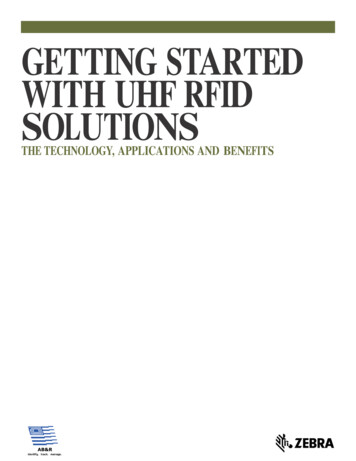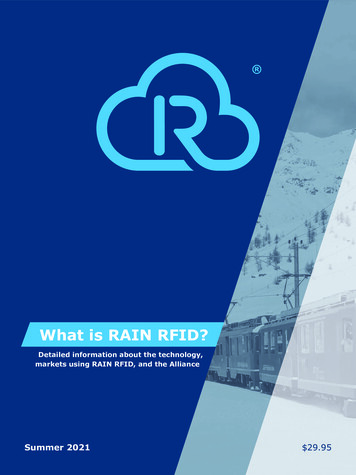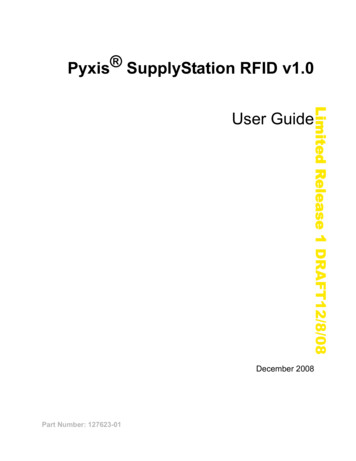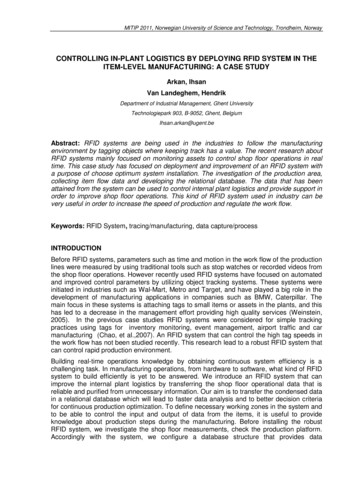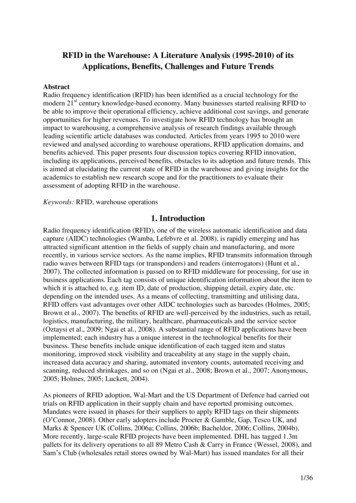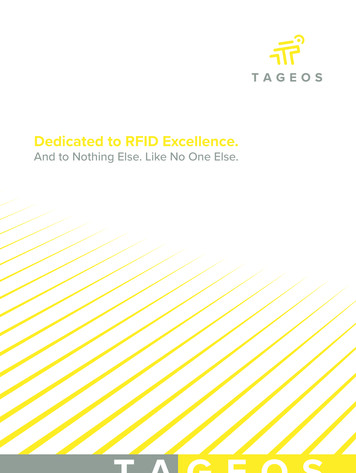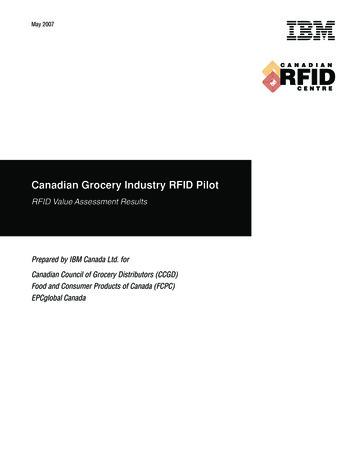
Transcription
Team Quicken Loans: Mobile RFID Inventory TrackingSystemProject PlanSpring 2014Michigan State University Student TeamJosh RasorJacob RiesserKeyur PatelQuicken Loans Professional TeamJim BrzuchPatrick HartfordSarah KindingerChristina MathesBryan WisnerBreanna PerrettChanning PritchettXulu Zhang
Mobile RFID Inventory Tracking System2014TABLE OF CONTENTSExecutive Summary . 3Functional Specifications . 4Example Use Case For Employee . 4Example Use Case #1 For Administrator . 4Example Use Case #2 for Administrator . 4Specifications . 5Design Specifications . 6Web Application . 6RFID Reader . 8Sequencing . 9Technical Specifications. 10System Architecture . 10Badge Scanner. 10RFID Scanner . 11Badge Scanner. 11Cabinet Guard . 11Web Application . 11Web Service . 11Database . 11Locking Mechanism . 11RISKS . 12Badge Scanner. 12Physical Locking Device . 12RFID Reader . 12Web API 2.1 . 12Timetable . 13Additional Information . 15Point of Contact . 15Acknowledgements . 152
Mobile RFID Inventory Tracking System2014EXECUTIVE SUMMARYThe RFID mobile device tracking system automates the process of checking mobile devices inand out of a secure lockbox. The mobile device testing group at Quicken Loans had been usingmanual logging to keep track of who had what mobile device checked out at any given time.This caused issues such as devices missing for extended periods of time, thus the teamdecided that an automated process would be more desirable.The RFID mobile device tracking system utilizes RFID tagging of the mobile devices inconjunction with in-place RFID scanners and employee authentication to automate the process.Each device will have a unique RFID tag affixed to it that will identify the device. The in-placeRFID scanner is responsible for detecting which tagged devices are present in the cabinet.Lastly, employees may access the storage area by authenticating themselves with theircompany assigned badge.A front-end web application replaces the manual logging. This application allows employees toview current inventory and check-out history. The front-end also has administrator interfaces tonotify employees in possession of checked-out devices, as well as providing managementfunctionality for devices and information pertaining to the devices.3
Mobile RFID Inventory Tracking System2014FUNCTIONAL SPECIFICATIONSThe following information regards the functional aspects of the RFID mobile device trackingsystem.EXAMPLE USE CASE FOR EMPLOYEEBob Jones needs to test some new code on a mobile test device. Bob logs into the webapplication in order to determine if there is a device that meets his needs in the Mobile DeviceCabinet.He approaches the Mobile Device Cabinet and swipes his security badge using the badgescanner on the cabinet. The system authenticates Bob’s security badge, immediately takes asnapshot of all the devices currently in the cabinet using RFID technology, and records thisdata. The cabinet door then unlocks, and he is free to take any device he chooses. Bob grabs aSamsung Galaxy S3 running Android version 4.3, closes the cabinet door, and scans his badge.The system then takes another snapshot of all devices in the cabinet, and determines whichdevice has been removed. The data is recorded in a database and available to be viewed andreported on via an internal webpage.When Bob finishes his testing, he returns to the cabinet and swipes his badge to open thecabinet. The system takes a snapshot using RFID technology of all devices currently in thecabinet. Bob places the device back into the cabinet and closes the door. The system takesanother snapshot and determines what devices have been placed back into the cabinet, andrecords the data. The system sends emails to both Bob and the Mobile Development QA teamwhen a device is checked in or out.EXAMPLE USE CASE #1 FOR ADMINISTRATORSally Admin is in charge of managing the devices in the Mobile Device Cabinet. She receives ashipment of new devices for testing purposes. Sally logs into the front-end web application andselects the option to add a new device. She enters the information for each new device on theweb application and confirms that each device was added. She then tags each device with anew RFID tag, scans her ID to open the cabinet, and places the devices inside. When thecabinet closes, the RFID reader reads the new devices and marks them as checked in.EXAMPLE USE CASE #2 FOR ADMINISTRATORTom Boss is also an administrator in charge of tracking the mobile devices in the cabinet. Hereceives a complaint from Norah Smith in the mobile device testing team that the mobile deviceshe needs to test on has been missing for a while. When Tom logs into the front-endapplication to view the device inventory, he confirms that the Samsung Galaxy S3 runningAndroid version 4.3 that Norah Smith is requesting has been checked out by Bob Smith for ayear. Tom chooses the administrator option to notify and selects the option to notify the currentpossessor. The front-end notifies the back-end web service, and the back-end web servicesends out an email to Bob Smith notifying him that the device is needed and that he has had itfor too long. Bob Smith receives the email and returns the phone the next day.4
Mobile RFID Inventory Tracking System2014SPECIFICATIONSThe Mobile RFID Inventory Tracking System conforms to the functional specifications describedherein.1. The system automatically checks devices in or out for employees; employees interactwith the system only by scanning their identification badge.2. The system authenticates users attempting to access the Mobile Device Cabinet.3. The system can determine the states of all registered devices at any time: to whomdevices have been checked out or if devices are physically present in the Mobile DeviceCabinet.4. A web application is available to review current inventory information, device history, anduser history.5. Furthermore, the web application can manage inventory information, such as registeringnew mobile devices.6. For mobile devices, the system maintains the RFID tag ID, device type, device name,device manufacturer, device operating system, and device operating system version.7. For users, the system maintains that user’s security badge number, common ID, firstname, last name, and extension number.8. When users check devices in or out, the system will maintain the device check in andout date and time.9. The system will send email to both the user and the Mobile Development QualityAssurance team providing information regarding the date and time the device waschecked in or out, and details about which devices were checked in or out.5
Mobile RFID Inventory Tracking System2014DESIGN SPECIFICATIONSThe following are the design specifications. These include front-end mock-ups and a systemsdiagram.WEB APPLICATIONThe web application is built on the .NET MVC framework and is styled using the TwitterBootstrap. The Quicken Loans styling guide provides visual consistency with other QuickenLoans products and solutions.The web application contains pages for device inventory, device history, and user history, asshown in the below three figures.Figure 1: Web Application Device Inventory PageAs shown in figure 1, the web application displays the list of all registered devices with theircurrent status and information. This design will draw on the web services to obtain the data.6
Mobile RFID Inventory Tracking System2014Figure 2: User History PageFigure 2 shows the web application’s view of all known sessions in which that user checked adevice out and checked it back in. Each user’s history is accessible and recorded. The webservice provides the list of all known users and their histories.Figure 3: Device History Page7
Mobile RFID Inventory Tracking System2014Figure 3 displays the web application’s device history view. A device’s history consists of allknown sessions in which any user checked that device out and later checked it back in. Eachdevice has its corresponding history tracked and can be viewed via the web application.RFID READERThe RFID reader must be able to take a snapshot of the mobile device inventory. The reader isequipped with an antenna which will monitor the Mobile Device cabinet. The antenna, shown onthe right in figure 4, must be placed such that all devices in the cabinet can be scanned by thereader.Figure 4: The Speedway Revolution reader with antennaThe RFID scanner can scan multiple tags simultaneously without requiring line-of-sight to eachdevice. Multiple antennae can be connected to the RFID scanner to handle larger cabinets.8
Mobile RFID Inventory Tracking System2014SEQUENCINGFigure 5: Sequence Diagram for employee use caseAs shown in figure 5, the user only interacts with the tracking system by scanning theiridentification and by receiving notifications. The locking device, RFID scanner, and badgescanner all communicate only to the cabinet guard, which in turn communicates with the webservice; the web service is equipped to handle requests from the inventory tracking system, theweb application, and possible future presentation-layer developments.9
Mobile RFID Inventory Tracking System2014TECHNICAL SPECIFICATIONSSYSTEM ARCHITECTUREThe Mobile RFID Inventory Tracking System consists of several sub-systems. The systeminvolves a locked cabinet, an RFID reader, a badge scanner, a database, a web service, and aweb application. The database, web service, and web application form a three-tier architecture,with business logic isolated in the web services layer. This architecture allows the presentationlayer, where the web application resides, to be extended.Figure 6: The system architecture of the RFID Tracking systemAs shown in figure 6, the three-tier architecture interfaces with the RFID reader and badgescanner at the business logic layer. Separating the web application from the web service allowsthe web service to be interfaced with possible future applications.BADGE SCANNERThe badge scanner allows users to interact with the tracking system. The badge scanner isaccessible outside of the Mobile Device cabinet, and communicates with both the web serviceand the locking device. When a badge is scanned, the cabinet unlocks and device inventorychanges are attributed to the badge’s owner via the web service.10
Mobile RFID Inventory Tracking System2014RFID SCANNERThe RFID scanning technology present in this system is the Impinj Speedway Revolution R420RFID Reader. The reader is equipped with Speedway Connect software. The readercommunicates with the Mobile RFID Inventory System via HTTP post with the followingvariables defined:BADGE SCANNERThe badge scanning technology present in this system is the RFIDeas RDR-6081AKU NFCBadge Reader. The reader runs without proprietary middleware. The badge scanner requires achannel to communicate with the locking system and the web services. The scanner depositstext to a connected device as a human-input-device. The connected device communicates withthe web service to identify users.CABINET GUARDThe cabinet guard integrates the services of the RFID Scanner, Badge Scanner, LockingMechanisms, and sends their information to the web service. The cabinet guard is a WindowsForms application, and runs on a device near the cabinet.WEB APPLICATIONThe front end web application uses .NET MVC 4.5. The web application is the top layer of thethree-tier architecture. The application is styled using the Twitter bootstrap and follows theQuicken Loans style guidelines for visual consistency. It communicates to the web service viaHTTP POST, GET, PUT, and DELETE.WEB SERVICEThe web services use Web API 2.0. This is the second layer of the three-tier architecture. Thislayer enforces business logic, and should be accessible for future top-layer applications. Thislayer provides the interface for the RFID scanner to modify the database based on snapshotreadings. The service uses Entity Framework to interface with the database.DATABASEThe backend database is built using Microsoft SQL 2014. It is the bottom layer of the three-tierarchitecture.LOCKING MECHANISMThe locking mechanism is a specialized lock solution for individual cabinets. The Cabinet Guardis designed to integrate with potential locking solutions. Because cabinets may be sospecialized with integrated locks, the Mobile RFID Inventory Tracking System does not containits own lock.11
Mobile RFID Inventory Tracking System2014RISKSBADGE SCANNER This system authenticates Quicken Loans employee to access the cabinet of devices andthen unlock the cabinet for device retrieval. Not receiving employee badge information in auseable form means that the system cannot properly track devices. Mitigation: The badge scanner inputs as a keyboard, and connects via USB; configurationand use is designed for simplicity.PHYSICAL LOCKING DEVICE Locking devices are highly specialized to cabinets; it is not feasible to develop a solution onlyfor particular systems. Mitigation: Add abstraction in Cabinet Guard to interface with highly specialized lockingsolutions.RFID READER Must receive information from RFID Reader, which exists on a network independently ofcomputers running Cabinet Guard Mitigation: Speedway Connect software handles the RFID reader’s output, allowing theCabinet Guard to read from a port on the RFID reader.WEB API 2.1 Front end for the website should reply on a backend API. Mitigation: Implementation of API resembles that of .NET MVC and basics of communicationare broken down into simple components. Unified services to handle JSON communication.12
Mobile RFID Inventory Tracking System2014TIMETABLEWeek 1 (1/6/14 – 1/10/14) Received project description First conference call with Quicken Loans TeamWeek 2 (1/13/14 – 1/17/14) Configured Team Computers Installed & Configured Windows 7 Installed & Configured Visual Studio 12 Installed & Configured Windows Server 2008 R2 Installed SQL Server Management Studio 14 Set-up GIT Repository Created a Skelton for Front End Email Mockups of Front EndWeek 3 (1/20/14 – 1/24/14) Status Report Presentations – January 22nd Configured SQL Server Management Studio 14 Activated IIS Installed Middleware on RFID Speedway Revolution Designed and implemented database schemas Implemented a Skeleton for web service Work on and complete Project Plan Document & PowerPointWeek 4 (1/27/14 – 1/31/14) Project Plan Presentation – January 27th Host prototype website on IIS Configure RFID reader to communicate with preliminary Cabinet Guard designsWeek 5 (2/3/14 – 2/7/14) Implement web service functionality Store and retrieve data from database Integrate badge scanner with Cabinet GuardWeek 6 (2/10/14 – 2/14/14) Implement simple front end website Prepare for alpha presentation, with complete check-in/check-outWeek 7 (2/17/14 – 2/21/14) Alpha Presentation – February 17th Continued development on front-end and web service functionalityWeek 8 (2/24/14 – 2/28/14) Usability tweaks to front-end Continue front-end and web service functionality13
Mobile RFID Inventory Tracking System2014Week 9 (3/10/14 – 3/14/14) Configure windows authentication Upgrade Cabinet Guard to Windows Forms applicationWeek 10 (3/17/14 – 3/21/14) Finalize usability constraints and definitions Implement all notification systemsWeek 11 (3/24/14 – 3/28/14) Prepare for presentations Develop API usability Finalize implementation of front-end CRUD operationsWeek 12 (3/31/14 – 4/4/14) Beta Presentations – March 31st Finalization of all features – use-case and administration functional and usable Documentation development Front-end nicetiesWeek 13 (4/7/14 – 4/11/14) Record audio and record screen for project video Finalize source code Develop manualsWeek 14 (4/14/14 – 4/18/14) Time cushion – plan for this time to be taken by emergencies and unforeseen problems Edit project video Develop manualsWeek 15 (4/21/14 – 4/25/14) Project Videos – April 21st Submit All Deliverables – April 23rd Design Day Setup – April 24th Design Day – April 25th14
Mobile RFID Inventory Tracking System2014ADDITIONAL INFORMATIONPOINT OF CONTACTFor further information regarding this document and project, please contact Dr. Wayne Dyksen atMichigan State University. All materials in this document have been sanitized for proprietary data. Thestudents and the instructor gratefully acknowledge the participation of our industrial collaborators.ACKNOWLEDGEMENTSWe would like to acknowledge the Quicken Loans team for their contribution and working with us on theSenior Design Program at Michigan State University. Moreover we would specially like to thank BreannaPerrett, Bryan Wisner, Channing Pritchett, Christina Mathes, Sarah Kindinger, Patrick Hartford, JimBrzuch, Xulu Zhang as well as any other persons we neglected to include.Additionally, we would like to thank Michigan State University Department of Computer Science,Malcom Doering, Dr. Wayne Dyksen in preparing us for the real world.15
Mobile RFID Inventory Tracking System 2014 3 EXECUTIVE SUMMARY The RFID mobile device tracking system automates the process of checking mobile devices in and out of a secure lockbox. The mobile device testing group at Quicken Loans had been using manual logging to keep track of who had what mobile device checked out at any given time.

